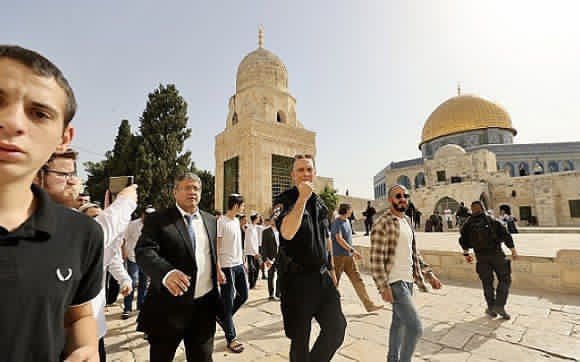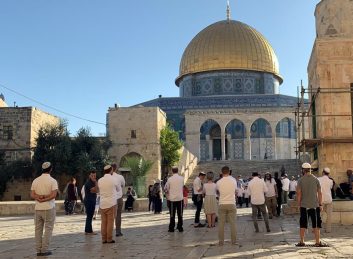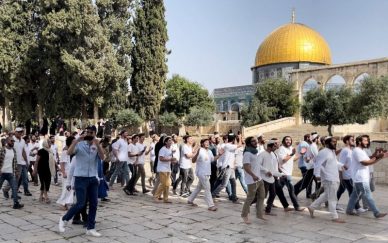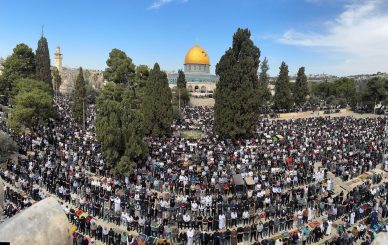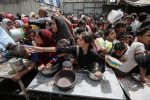OCCUPIED JERUSALEM, (PIC)
More than 2,567 Jewish settlers stormed the blessed Al-Aqsa Mosque during the days of the Festival of Lights “Hanukkah,” which extended from December 26 to January 2. The seventh day of the festival recorded the highest number of incursions, followed by the eighth day, during which the settlers committed numerous violations, the most notable being the Israeli extremist security minister Ben Gvir’s incursion into Al-Aqsa, performing the priestly blessing, prostrating, lighting candles, dancing, singing, and wearing “Tefillin” wraps. What are these extremist settlers aiming for by establishing all these rituals and solidifying this phase of aggression against the blessed Al-Aqsa Mosque?
In this context, researcher specializing in Jerusalem affairs, Ziad Abheis, provided a detailed reading of the Hebrew “Hanukkah” aggression and its implications for the blessed Al-Aqsa Mosque, which ultimately aims at a “moral foundation for the alleged temple” in preparation for realizing their alleged dreams and myths of establishing it physically on the ruins of the Muslims’ first Qibla and the third holiest site in Islam.
Abheis said in his assessment of the situation that the Hebrew Hanukkah aggression this year aimed at solidifying this occasion as a fifth fundamental station for aggression against Al-Aqsa to address the long gap in the Torah holidays between the 10th month of the Gregorian year and the 3rd month of the following year.
Establishing a central season of aggression
He pointed out that the primary goal during this time was to escalate the incursions in quantity by increasing the number of intruders and in quality by intensifying the imposition of Torah rituals in the blessed Al-Aqsa Mosque, considering it a moral foundation for the alleged temple, paving the way for its material establishment. This year’s aggression witnessed several developments.
According to the Jerusalem affairs researcher, the first important issue concerns solidifying Hanukkah as a central season of aggression, where the “Festival of Lights” extended over eight days from Thursday, December 26, 2024, to Thursday evening, January 2, 2025, interspersed with six days of incursions due to the closure of the entry gates on Friday and Saturday, witnessing a total of 2,567 extremist Jewish intruders, averaging about 428 intruders daily with fluctuations in numbers between its days.
He highlighted that this indicates numerically that the extremist temple groups succeeded in raising the number of intruders by 53% during “Hanukkah” compared to 2022, when it reached 1,681 intruders with an average of 280 daily. This allows it to shift from the category of marginal holidays to the second rank among Torah holidays in terms of employing it to storm Al-Aqsa, as the average daily incursions are now nearing the number of intruders during the Hebrew New Year, for example.
Imposing Torah rituals
The second issue according to Abheis relates to the imposition of Torah rituals, as this year’s Hebrew Hanukkah aggression witnessed the lighting of “Hanukkah candles” in its eastern plaza for the third time in history after two timid attempts in 2021 and 2023. However, this time it occurred on the penultimate day, and the eight candles of the festival were lit, albeit timidly. This is the first time the Hanukkah candles were fully lit inside Al-Aqsa Mosque, even in the absence of the menorah and religious tools, renewing the establishment of the eastern plaza of Al-Aqsa as if it were the unofficial Jewish synagogue inside the Mosque.
He continued: Additionally, on the first day of the aggression, Thursday, December 26, the Hanukkah dance, which had been performed for years at the gates of the Mosque, was transferred inside, a rare precedent that might also be the first in the history of imposing Torah rituals in the blessed Al-Aqsa Mosque, according to available documentation. Furthermore, the “priestly blessings” rituals were performed daily throughout this Torah holiday, qualifying them to become a new Torah ritual that is being normalized in Al-Aqsa alongside the epic prostration that has been performed daily since the extremist minister Itamar Ben Gvir endorsed it on August 13, 2024, as well as the blowing of the shofar, morning and evening prayers, coming-of-age rituals, and additional prayers during the holidays, all of which have unfortunately been normalized within Al-Aqsa over the past years.
On the level of imposing religious tools, Abheis confirmed that for the third time in the Mosque’s history since its occupation, a settler wearing black prayer wraps (Tefillin) stormed it. This is the fourth daily prayer tool alongside the prayer shawl (Tallit), fringe (Tzitzit), and the prayer book (Siddur), all of which have seen repeated attempts to impose them inside Al-Aqsa, after temple groups submitted a petition to allow their entry into Al-Aqsa before the occupation’s supreme court in 2022.
Abheis noted that the Old City was isolated at night, specifically along the Qattanin path and in the Al-Ghazali square in front of the Gate of the Tribes, and the menorah was lit in its almost complete form in front of the Qattanin gate in a recurring ritual since 2017, in addition to lighting the menorah in the Buraq square with the participation of ministers and rabbis, a ritual that has been repeated since the occupation.
Enhancing the political aspect for supporters of religious Zionism
The third issue from the perspective of the Jerusalem affairs researcher concerns the political aspect, as the first day of the Torah “Festival of Lights” witnessed the seventh incursion of the National Security Minister Itamar Ben Gvir since he assumed office in January 2023, and the fourth since the “Al-Aqsa Flood” operation and the beginning of the extermination war on Gaza. This was the third incursion in which Ben Gvir personally led the aggression against Al-Aqsa during a Torah holiday from his official position, indicating that he continues to treat the Judaization of Al-Aqsa as the primary space to fulfill his electoral promises and maintain his popularity among supporters of religious Zionism, who still aspire to complete the list of eleven demands submitted to him upon taking office.
Restoring light to the temple mount!
Settlers lit candles for the “Hanukkah” festival in Al-Aqsa Mosque in Jerusalem. They lit candles in Al-Aqsa and held collective prayers during this, celebrating the seventh day of the holiday and lighting the last candle.
The settlers published a photo of the candles in Al-Aqsa along with their claims that: “This holiday has restored light to the Temple Mount.”

